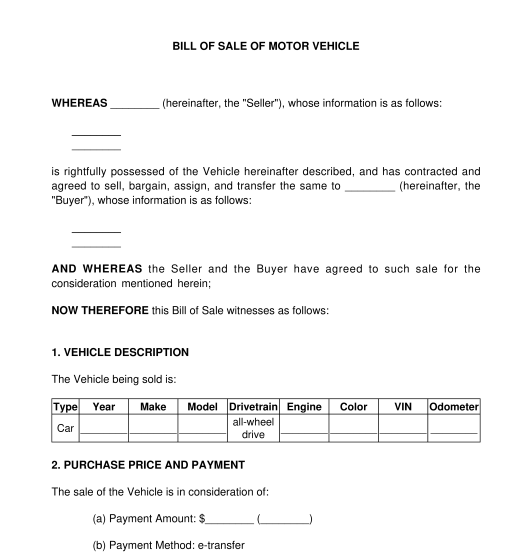 20/10/2025
20/10/2025

Answer a few questions and your document is created automatically.

Your document is ready! You will receive it in Word and PDF formats. You will be able to modify it.

 20/10/2025
20/10/2025
 Word and PDF
Word and PDF
 2 to 3 pages
2 to 3 pages
A Bill of Sale is a legal document that the seller usually gives to the buyer when selling property. Specifically, a Bill of Sale of Motor Vehicle is a document the seller gives to the buyer when the transaction involves a motor vehicle.
A bill of sale is a document for the buyer and is similar to an ownership deed. The document helps prove that ownership rests with the buyer after purchase.
There are two types of Bills of Sale of Motor Vehicles:
The most common type of Bill of Sale of Motor Vehicle is an as is bill of sale. This means that the seller has not certified the vehicle before selling it and the bill of sale provides no warranties or assurances as to the vehicle's quality or fitness for purpose. In that case, the buyer will be responsible for inspecting the vehicle and ensuring that the vehicle meets their demands.
No. Having a Bill of Sale of Motor Vehicle isn't necessary in order to finalize the transaction.
Having a bill of sale is an important document that shows proof that the buyer now retains legitimate ownership of the vehicle.
Although the vehicle ownership may be changed and registered in the name of the buyer, having a bill of sale solidifies that the new registered owner is in fact the true owner and purchaser of the vehicle. A Bill of Sale of Motor Vehicle may help prevent future misunderstandings or disputes.
A Bill of Sale of Motor Vehicle must contain:
Also, the Bill of Sale should contain conditions from the seller about title to the property, and the right to sell such property.
A buyer and seller may sign a Bill of Sale of Motor Vehicle. The signatories must be of majority age and not under a disability. The ages of majority are as follows:
It is possible that the seller or the buyer may be business entities, such as:
The document must be filled out, signed by the seller and the buyer, and then given to the buyer in exchange for money. At the time of purchase, print out two copies, or sign electronically and forward copies by email, and sign each of them so that both parties have a copy of the bill of sale.
After the document is signed, the new owner will need to change the ownership of the vehicle. When the Buyer attends the provincial or territorial government office to change the vehicle ownership into their name, they must present the signed Bill of Sale to determine and pay any applicable sales taxes. The province or territory may simply utilize the fair market value of the vehicle. Once the sales taxes have been paid, the ownership will be changed from the seller's name to the buyer's name. The government may provide a new ownership document.
The Bill of Sale of Motor Vehicle should accompany the existing ownership of the vehicle. This is a small piece of paper that identifies the owner and describes the vehicle.
The ownership will be required in order to change the name from the seller to the buyer at the provincial or territorial government office.
Finalizing the Bill of Sale of Motor Vehicle itself will not incur additional fees. However, changing the ownership of the vehicle from the seller to the buyer at the provincial or territorial government office will require the payment of sales taxes, which is usually based on the fair market value of the vehicle. For instance, is vehicle value is is $5000.00 and the tax rate is 13%, the amount payable would be $650.00.
There are many laws in place governing the sale of vehicles. Consumer protection and sales of goods laws protect buyers from unscrupulous sellers with implied conditions that generally can't be waived unless privately sold as is, which still has exceptions. These implied conditions include the buyer obtaining a vehicle free from liens, conforming to the description, and more.
Many jurisdictions require sellers to provide buyers with a Used Vehicle Information Package. Furthermore, under the Canada Weights and Measures Act (R.S.C., 1985, c. W-6), it is an offence to alter a vehicle's odometer. Some pieces of legislation on consumer protection include the following:
You fill out a form. The document is created before your eyes as you respond to the questions.
At the end, you receive it in Word and PDF formats. You can modify it and reuse it.
Bill of Sale of Motor Vehicle - Template - Word and PDF
Country: Canada (English)